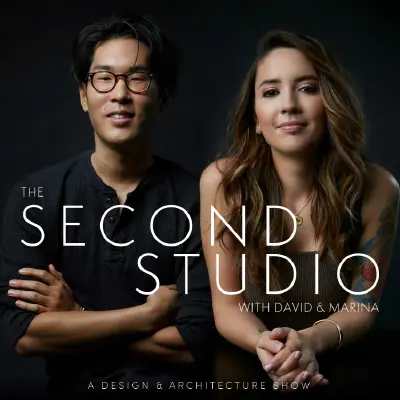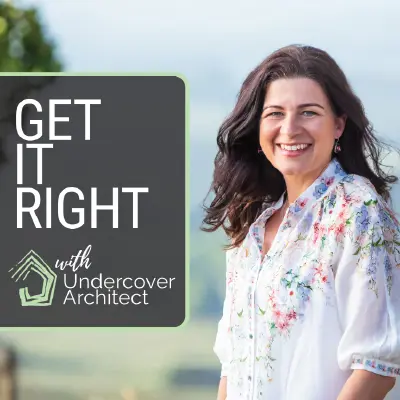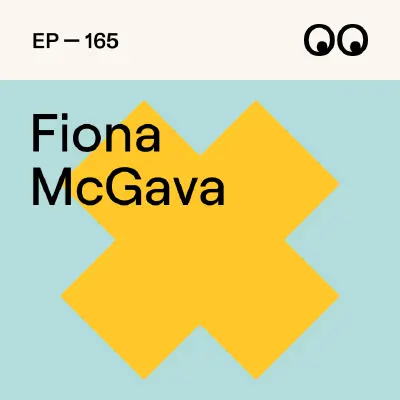Podcasts about Design
Episodes about Design

Jul 11, 2025
Khatt Chronicles in Conversation with Kinda Ghannoum
Khatt Chronicles: Stories on Design from the Arab World ❭
Huda Smitshuijzen AbiFarès interviews Brussels-based, Syrian-Polish designer Kinda Ghannoum. They discuss her journey into the field of design, through practical work following her graduation with a degree in architecture from the University of Damascus.Kinda shares her travails as a self-taught graphic designer and her passion for the Arabic script, lettering and typography. The conversation centers around issues of preservation of identity while saddling two nationalities, and of providing educational resources to design students in Syria and preserving Syrian design history, as well as what it means to be practicing in a diasporic context. A number of Kinda's remarkable projects are discussed starting with her seminal archival project, The Syrian Design Archive, that she set up with two friends – Sally Alassafen and Hala Al Afsaa – in 2020 during her postgraduate studies in Belgium. Kinda also discusses some of her other significant projects where cultural advocacy and collaboration was at the core.What transpires from this conversation is an image of a courageous and dedicated woman designer that breaks any stereotypes of women from the Southwest Asia and North Africa (SWANA) region. Kinda's work is featured in the book "Revealing Recording Reflecting: Graphic Women from Southwest Asia and North Africa" (Amsterdam: Khatt Books, 2024).
FOLLOW & RATE KHATT CHRONICLES:» Apple Podcasts: https://podcasts.apple.com/us/podcast/khatt-chronicles-stories-on-design-from-the-arab-world/id1472975206» Spotify: https://open.spotify.com/show/3ATH0MwO1tIlBvQfahSLrB» Anghami: https://play.anghami.com/podcast/1014374489THIS SERIES IS PART OF THE AFIKRA PODCAST NETWORK Explore all episodes in this series: https://www.youtube.com/playlist?list=PLfYG40bwRKl5mMJ782dhW6yvfq0E0_HhAABOUT AFIKRAafikra | عفكرة is a movement to convert passive interest in the Arab world to active intellectual curiosity. We aim to collectively reframe the dominant narrative of the region by exploring the histories and cultures of the region – past, present and future – through conversations driven by curiosity.📍 Local events in 40+ locations worldwide http://afikra.com/chapters🎧 New podcasts + videos weekly http://afikra.com/podcasts⚡ Become a member: https://www.afikra.com/membership🔗 Instagram: https://www.instagram.com/afikra_🔗 Facebook: https://www.facebook.com/afikra.official🔗 Twitter: https://twitter.com/afikra

Jul 10, 2025
Repost: The tale of Prickly Thistle - With Clare Campbell (#132)
Garmology - A podcast about clothes, and stuff. ❭
Repost: This week I'm heading back to Scotland for a chat with Clare Campbell of Prickly Thistle, a self-proclaimed rebel mill outside Inverness. From a background as a chartered accountant, Clare took a u-turn, or maybe a swerve, when she discovered a passion for the traditional tartan and from there decided to establish a mill, using ancient looms, with no clue at all about how to use them. We get into what it means to run an ethical and transparent business, getting off social media, going zero waste, what B Corp status means and how being a rebel can mean doing this the opposite way of established business practices.You can find Prickly Thistle on the web at pricklythistle.shop.
Garmology is by Nick Johannessen. There is no advertising or sponsorship, but you are welcome to support the podcast via my Patreon at patreon.com/garmology or you can buymeacoffee.com/garmologyNick Johannessen is also the editor of the WellDressedDad blog and WellDressedDad on Instagram. You can email Nick as Garmology (at) WellDressedDad.com.Garmology theme music by Fabian Stordalen.

Jul 10, 2025
The Thursday Show: Bernie de Le Cuona on her brand’s big move. Plus: A new deadline for the pause on tariffs
Business of Home Podcast ❭
Host Dennis Scully and BOH editor in chief Kaitlin Petersen discuss the biggest news in the design world, including the latest on tariffs, a first look at the summer issue of BOH magazine and a designer podcast that puts clients in the spotlight. Later, Bernie de Le Cuona joins the show to discuss her brand's big move. This episode is sponsored by LoloiLINKSde Le CuonaBusiness of Home


Jul 08, 2025
#456 - Ana Duran, Co-Principal of Estudio A0 & Assistant Professor at Yale School of Architecture.
The Second Studio Design and Architecture Show ❭
This week David and Marina of FAME Architecture & Design are joined by Ana Maria Duran Calisto, Co-Principal of Estudio A0 and Daniel Rose Visiting Assistant Professor at the Yale School of Architecture. The three discussed the shift in relationship between technology, culture and nature in architecture; the cultural background of South America; architecture and the Amazonia; the colonial and monocultural mindset; Ana’s educational background; shifting career paths; the University of Amazonia design competition; and more. This episode is supported by Autodesk Forma & Autodesk Insight • Programa • Learn more about BQE CORE SUBSCRIBE • Apple Podcasts • YouTube • Spotify CONNECT • Website: www.secondstudiopod.com • Office • Instagram • Facebook • Call or text questions to 213-222-6950 SUPPORT Leave a review EPISODE CATEGORIES • Interviews: Interviews with industry leaders. • Project Companion: Informative talks for clients. • Fellow Designer: Tips for designers. • After Hours: Casual conversations about everyday life. • Design Reviews: Reviews of creative projects and buildings. The views, opinions, or beliefs expressed by Sponsee or Sponsee’s guests on the Sponsored Podcast Episodes do not reflect the view, opinions, or beliefs of Sponsor.David Lee and Marina Bourderonnet

Jul 07, 2025
When Sustainability Meets Real Life: The Perfect Home, with Shauna
Get It Right with Undercover Architect ❭
Hello! This is Episode 364, and in it, HOME Method member, Shauna, is back with Part 2 of our conversation about building her new family home. In this episode, we dive deeper into the long-term view Shauna took with this home, and how that shaped her decisions around budget, investment, and design. And you’ll hear how she tested her thinking along the way, continually asking herself if her choices were still delivering a better result than the alternatives. [For all resources mentioned in this podcast and a free, downloadable PDF transcript, head to www.undercoverarchitect.com/364] If you haven’t listened to Part 1 of my conversation, be sure to head ot Episode 363, where you’ll hear Shauna introduce her project, and discuss how she embarked on her design process balancing sustainability goals, her budget and a complex site. You can find it at www.undercoverarchitect.com/363 In this episode, we explore how Shauna navigated her decision to go with a Design-Build builder, and how she set herself up for success in that relationship. She followed my guidance on risk awareness, and you’ll hear the smart ways she ensured clear communication, transparency, and alignment right from the start. Shauna shares how she handled the contract and construction process, and the tools and mindset that helped her manage changes, call out errors, and advocate for what she needed, without fear of how she’d be seen or friction in her communication. And we also talk about how she decided where to invest her time and energy, and the thoughtful, strategic trade-offs she made to suit her lifestyle, family needs, and values, while still achieving a high-performing and deeply satisfying home. As someone who has the benefit of living now in her finished home and being aware of what she’s achieved, as well as her key learnings along the way, I know Shauna has a wealth of knowledge and information to share with you that will be hugely beneficial for your project - whether you’re building new or renovating. Remember, if you’d like to grab a full transcript of this episode, plus links to some helpful resources, you can find that by heading to www.undercoverarchitect.com/364. Now, let’s dive in! RESOURCES MENTIONED IN THIS PODCAST: For links, images and resources mentioned in this podcast, head to >>> www.undercoverarchitect.com/364 Accessing my free '44 Ways' E-Book will simplify sustainability and help you create a healthy, low tox and sustainable home. You can download your free copy here >>> https://undercoverarchitect.com/ways Access the support and guidance you need to be confident and empowered when renovating and building your family home inside my flagship online program >>> https://undercoverarchitect.com/courses/the-home-method/ Just a reminder: All content on this podcast is provided by Undercover Architect for reference purposes and as general guidance. It does not take into account specific circumstances and should not be relied on in that way. You should seek independent verification or advice before relying on this content in any circumstances, including but not limited to circumstances where loss or damage may result. The views and opinions of any guests on the podcast are solely their own. They may not reflect the views of Undercover Architect. Undercover Architect endeavours to publish content that is accurate at the time it is published, but does not accept responsibility for content that may or has become inaccurate over time.See omnystudio.com/listener for privacy information.

Jul 06, 2025
165. Rewilding Comms: Fiona McGarva on Glastonbury, Print, and Creative Freedom
The Creative Boom Podcast ❭
In this episode of The Creative Boom Podcast, Katy Cowan is joined by Fiona McGarva, founder of Sundae Communications and longtime collaborator with Shangri-La at Glastonbury Festival.
They explore how Fiona and the team have completely reimagined how they communicate with audiences—ditching traditional social media announcements in favour of handmade risograph posters, seed packets, and direct, analogue experiences that celebrate slowness and real-world connection.
Fiona shares how Shangri-La's new theme, 'The Wilding', is more than just a creative direction—it's a complete reset, inviting us all to consider how we share stories, connect with people, and move away from platforms we don't truly own. The conversation is a refreshing and empowering reminder that creativity can flourish in new ways, especially when we embrace age, messiness, and the freedom to do things differently.
Together, Katy and Fiona reflect on their careers in PR, the shifts they've seen across media and design, and the joy of doing things on your own terms. Expect nostalgia, a few Pedro Pascal tangents, and plenty of wisdom on everything from personal growth to rediscovering magic in our work and lives.
This season is proudly sponsored by the School of Communication Arts.

Happy Fourth of July to everyone out there, as I record this on the day before the 4th. For those in the US, this is the day that we celebrate our independence from the British. No offense to our British listeners. But to be fair, we are not alone in our desire to kick the British out. Nice to see that we could put that ugliness behind us. Now we are happy to closely monitor Royal Family news, refurbish British shows to suit our own tastes, welcome musical acts, and occasionally drink tea and have small sandwiches. For those in other parts of the world, hope you are still able to celebrate July 4th as a good day. I am preparing to once again teach my course on employee experience. One of the challenges of teaching a general class is that you realize how much you could cover and how much there is to talk about. Also, things are rapidly changing the world of work which needs to be considered and covered. Despite all of these changes, there are constants that exist which form the foundation of employee experience. We might think that the more things change, the more they stay the same. To be successful in any experience design effort, we have to keep the fundamentals in mind.On this episode of Experience by Design, I welcome Brian Kurtz to the show to talk about his career in direct marketing. But Brian is about more than just direct marketing. Turns out that he started out as a film critic and film editor, even doing film reviews for the New York Times. That led him to pursue a PhD in English at Idaho State University. While that didn’t pan out, it did solidify his analytical approach to designing communications that resonate with target audiences no matter the method through which it is disseminated.We talk about all the changes that he has seen in his long career in direct marketing, including the changes happening today. We also explore how despair these changes, the fundamentals remain the same. He describes his book Overdeliver, and how we need to approach business not as a revenue event but as relationship events. People are more than lists and segments. To be successful in breaking through the noise, we need to design messages and content that connects. And we talk about the biggest challenges with being a baseball umpire.

The AI gold rush is here and it’s changing banking forever. Artificial Intelligence isn’t just a buzzword anymore — it’s reshaping the future of banking. In this episode, we explore how AI, especially generative AI, is driving a new era of customer experience, operational efficiency, and service personalisation across the financial sector.Through real-world examples from global institutions such as JPMorgan Chase, Bank of America, and NatWest, we explore how banks are leveraging AI for proactive engagement, self-service solutions, enhanced fraud detection, and improved accessibility. Find out:Key shifts in AI strategy and adoption in financial servicesBenefits and real challenges of implementing AI across banking functionsHow AI is redefining customer expectations and transforming CX worldwideRead the full article on UXDA's blog: https://www.theuxda.com/blog/ai-gold-rush-21-digital-banking-ai-case-studies-cx-transformation* AI podcast on UXDA article powered by Google NotebookLM

Jul 02, 2025
Episode 723: Drawing from her family’s horticulture roots, Michigan-based farmer-florist Erin Webb of Florista of West Olive shares a farm tour and design demonstration
SLOW FLOWERS with Debra Prinzing ❭
Erin Webb grew up immersed in plants and horticulture, following three generations of Michigan ornamental nursey owners before her. For as long as she can remember, Erin was immersed in the business of plants. After studying business and Spanish in college, and after an initial career in corporate America, in 2019, Erin returned to the […]
The post Episode 723: Drawing from her family’s horticulture roots, Michigan-based farmer-florist Erin Webb of Florista of West Olive shares a farm tour and design demonstration appeared first on Slow Flowers Podcast with Debra Prinzing.


